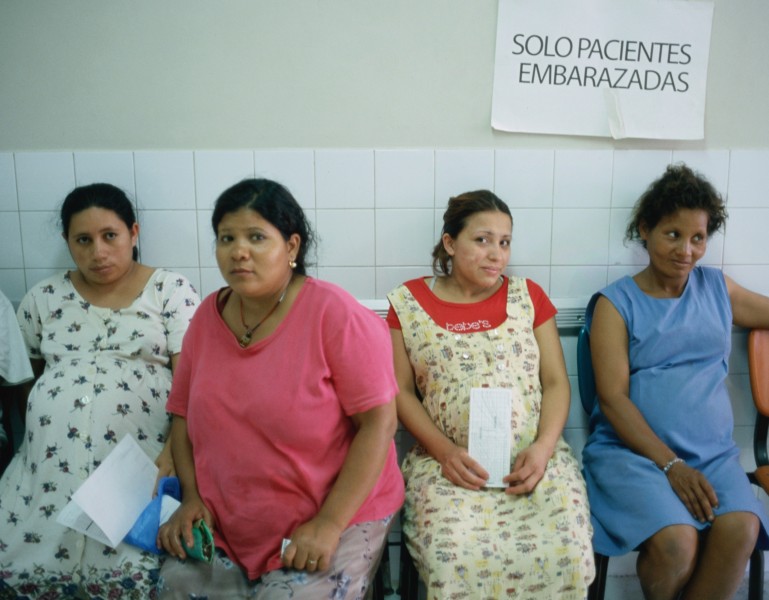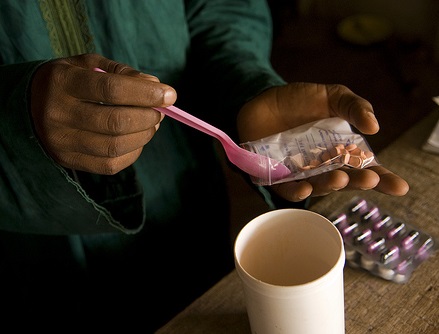Drugs for preventing malaria reduced the risk of malaria infection by 56% for all pregnant women and 82% for women in their first or second pregnancies.



Photo Credits: Unknown (L), Alfredo Srur (C), Arne Hoel (R)
![]()
![]()
![]()
Why are drugs for preventing malaria in pregnant women important?
- Women pregnant for their first or second time who live in malaria endemic areas are at greater risk for malaria infection than non-pregnant women of similar ages. Malaria infection during pregnancy can result in antenatal anemia (deficiency of red blood cells during pregnancy) and can slow fetal growth.
Do they work?
- Malaria medication provided to pregnant women to prevent malaria is effective in reducing the risk of malaria infection by 56% for all women. For women in their first and second pregnancies, malaria medication reduced the risk of infection by 82%, reduced the risk of severe anemia by 50%, and also reduced the risk of fetal death by 27%.
Equity: do they work in the disadvantaged?
- The majority of malaria cases occur in developing countries especially within disadvantaged populations. Therefore, effective treatments for malaria can help improve survival among the disadvantaged.
Intervention Delivery
- Ten malaria prophylaxis trials used chloroquine, pyrimethamine, proguanil, pyrimethamine-dapsone, or mefloquine and compared them to no intervention or placebo. One study compared chloroquine with proguanil.
- Three studies used intermittent preventive treatment interventions (IPT) with sulfadoxine-pyrimethamine versus placebo. Two compared IPT to chloroquine prophylaxis.
- Seven of the studies provided oral iron and folic acid supplements.
Population and Setting
- Seventeen trials, enrolling 20,256 pregnant women, were included in the review
- One of the included studies was conducted in Thailand (unstable malaria) and all others were conducted in highly malaria endemic countries in Africa (including Burkina Faso, Cameroon, the Gambia, Kenya, Malawi, Mali, Mozambique, Nigeria, Tanzania, Uganda).
- Some trials recruited only women in their first or second pregnancies while others included all pregnant women.
Summary of Findings [SOF] Tables: Drugs for preventing malaria in pregnant women
Patient or population: Pregnant women of all parity groups
Settings: countries in Africa and Thailand
Intervention: Any antimalarial drug
Comparison: No drug
| Outcomes
| Anticipated absolute effects per year | Relative Effect (95% CI)
| No of Participants (studies)
| Quality of the evidence (GRADE)
| |
| Risk without LSM (Control) | Risk difference with LSM (95% CI) | ||||
| Antenatal parasitemia | 23.5 per 100 | 11.0 fewer per 100 (from 3.3 to 17.8 fewer) | OR 0.44 (0.25-0.80 | 328 (2) | Moderate1 |
| Placental malaria | 24.2 per 100 | 16.0 fewer per 100 (from 13.3 to 17.9 fewer) | OR 0.26 (0.19-0.37) | 1236 (3) | Moderate2 |
| Adverse Events: None reported | |||||
| About quality of evidence (GRADE) | |||||
| 1. Small samples sizes in the two included studies.
Summary of Findings [SOF] Tables: Drugs for preventing malaria in pregnant women | |||||
Patient or population: Pregnant women in first or second pregnancy
Settings: countries in Africa and Thailand
Intervention: Any antimalarial drug
Comparison: No drug
| Outcomes
| Anticipated absolute effects per year | Relative Effect (95% CI)
| No of Participants (studies)
| Quality of the evidence (GRADE)
| |
| Risk without LSM (Control) | Risk difference with LSM (95% CI) | ||||
| Severe antenatal anemia | 13.4 per 100 | 5.1 fewer per 100 (from 2.9 to 6.7 fewer) | OR 0.50 (0.39-0.65) | 2809 (4) | Moderate1 |
| Antenatal parasitemia | 29.6 per 100 | 21.6 fewer per 100 (from 16.6 to 24.6 fewer) | OR 0.18 (0.14-0.22) | 2906 (7) | Moderate2 |
| Placental malaria | 35.0 per 100 | 18.2 fewer per 100 (from 9.8 to 21.7 fewer) | OR 0.36 (0.29-0.45) | 1805 (6) | Moderate2 |
| Perinatal death | 8.7 per 100 | 2.3 fewer per 100 (from 0.09 to 4.07 fewer) | OR 0.70 (0.50-0.99) | 1986 (3) | High |
| Low birthweight | 15.5 per 100 | 6.6 fewer per 100 (from 4.33 to 8.34 fewer) | OR 0.52 (0.40-0.67) | 2350 (7) | High |
| Birthweight | The mean difference in birthweight was 126.70 g more among intervention infants than controls | MD 126.70 (88.64-164.75) | 2648 (9) | High | |
| Adverse Events: None reported | |||||
| About quality of evidence (GRADE) | |||||
1. One trial studied prophylaxis, the others studied IPT. All but one study had wide confidence intervals that indicated both positive and negative effects.
2. High heterogeneity.
Relevance of the review for disadvantaged communities.
Findings | Interpretation |
| Equity - Which of the PROGRESS groups examined | |
| All studies included women from low and middle income countries. Most of the studies were conducted in Africa and one was conducted in Thailand. | The results of this review are likely applicable to pregnant women in other countries affected by malaria. |
| No other information on PROGRESS groups is provided. However, many trials relied on data from deliveries in hospital. | The most disadvantaged women, including those who may be poorer or from rural areas, may not have delivered in hospital and therefore are not included in these results. |
| Equity Applicability | |
| All included studies were conducted in low and middle income countries. All but one were conducted in malaria-endemic countries of Africa. One study was conducted in an area of unstable malaria in Thailand. | The results of this review are likely applicable to pregnant women in other countries affected by malaria. However, the interventions were found to be most effective in women with lower parity (in their first and second pregnancies). |
| Sulfadoxine-pyrimethamine is feasible and practical to implement, however IPT in areas with sulfadoxine-pyrimethamine present challenges. | Policymakers implementing a malaria prevention program should determine the likelihood of drug resistant malaria and choose prophylaxis or IPT accordingly. Insecticide-treated bednets are also effective in pregnancy and should be used in combination with medication. |
| Cost-equity | |
| None of the included studies reported on the cost-equity of providing malaria prophylaxis or IPT to pregnant women. | Policymakers who plan to implement a malaria prophylaxis or IPT intervention should examine the costs associated with the medication, personnel to provide it, follow up with pregnant women taking the medication, and should include a strategy to ensure the most disadvantaged women are able to benefit from the intervention (e.g. provide transportation vouchers to get to the hospital, provide subsidized/free medication, etc.). |
Comments on this summary? Please contact Jennifer Petkovic.
